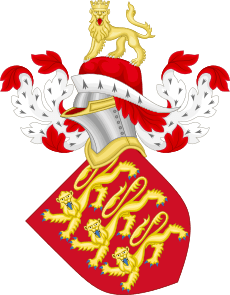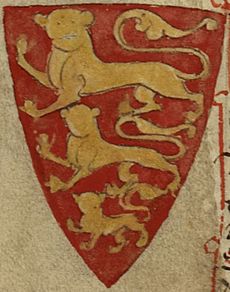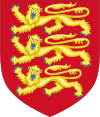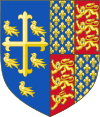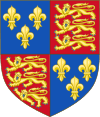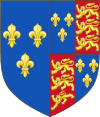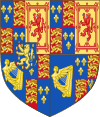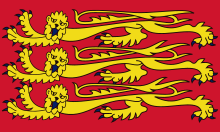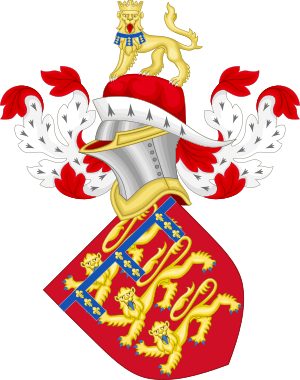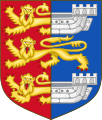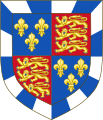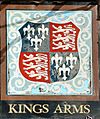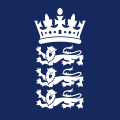Coat of arms of England facts for kids
Quick facts for kids Royal arms of England(Arms of Plantagenet) |
|
|---|---|
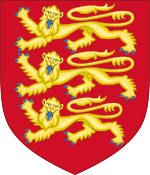 |
|
| Versions | |

Banner of arms, which served as royal banner
|
|
| Armiger | Monarchs of England |
| Adopted | Late 12th century |
| Blazon | Gules, three lions passant guardant in pale or armed and langued azure |
| Supporters | Various |
| Motto | Dieu et mon droit |
| Order(s) | Order of the Garter |
| Use |
|
The royal arms of England is a special coat of arms that was historically used by the kings and queens of the Kingdom of England. Today, it is a symbol for England in general. These arms were first used around the year 1200 by the Plantagenet kings. They continued to be used by all English and British monarchs after that.
Currently, you can see the English royal arms as part of the United Kingdom's coat of arms. They are combined with the arms of Scotland and Ireland. In the past, they also included the arms of France (because English kings claimed the French throne) and Hanover. The arms are still used to represent England in different ways. For example, they appear in the arms of Canada. They are also used by English sports teams, like the Football Association and the England and Wales Cricket Board.
Contents
What Do the Royal Arms Look Like?
The royal arms of England have a red background. On this background, there are three gold lions with blue claws and tongues. The lions are shown walking forward with their right front paw raised. Their heads are turned to face you. In heraldry (the study of coats of arms), this is called "three lions passant guardant in pale." This means they are walking but looking at you. Even though they are called "lions," in old heraldry, this pose was sometimes called "leopards."
When the Kingdom of England existed, the arms were usually part of a full "achievement." This is a complete display that includes the shield, a crest, and supporters. The look of this achievement changed over many years.
The Crest and Crown
The first time a crest appeared on the royal arms was during the reign of King Edward III. His official seal showed a helmet above the arms. On top of the helmet was a crowned gold lion standing on a special cap called a chapeau. This design has stayed mostly the same since then. It got its current look during the time of King Henry VIII.
Over time, the chapeau was replaced by a crown. The design of the crown changed too. It used to be an open circle with fleurs-de-lys (stylized lily flowers) or leaves. Later, during King Henry VI's reign, it changed to include crosses. The crown gained a single arch under King Edward IV and a double arch under King Henry VII. Since the late 1600s, the crown has a jeweled circle with alternating crosses and fleurs-de-lys. It also has two arches that meet at the top with a small globe (called a monde) and another cross.
The Helmet and Mantling
The helmet that held the crest was first a simple steel design. Sometimes it had gold decorations. During Queen Elizabeth I's time, it changed to a gold helmet with a barred visor, facing forward. This specific helmet design is only used for royal arms. At the same time, the decorative cloth (called mantling) behind the shield also changed. It used to be red cloth lined with ermine (a type of fur). It was changed to gold cloth lined with ermine.
Animal Supporters
Animal supporters are figures on either side of the shield that seem to hold it up. They first appeared in English heraldry in the 1400s. They weren't always a fixed part of the arms and often changed. Many medieval kings' supporters were actually made up later during the Tudor period. But they are still used to represent those kings today, for example, at St. George's Chapel, Windsor Castle.
The supporters became more consistent under the Tudors. By Elizabeth I's reign, they were usually a red Welsh dragon and a gold lion. After the Union of the Crowns in 1603, when England and Scotland shared a king, the Stuart monarchs changed the dragon to a Scottish unicorn. Since then, the lion and unicorn have remained the supporters of the royal arms.
Mottoes and Orders
The English royal arms were often shown surrounded by the Order of the Garter. This is England's highest award for knights. It is a blue circle with the order's old French motto: Honi soit qui mal y pense ("Shame be to him who thinks evil of it").
A motto has also been shown on a scroll below the arms since at least the time of King Henry IV. He used the motto Sovereyne ('Sovereign'). The current motto, Dieu et mon droit ("God and my right"), was first used by King Henry V. However, it didn't become the standard motto until 1714.
History of the Royal Arms
Lions were used as symbols by early groups like the Vikings and Saxons. But a formal system for coats of arms, called English heraldry, really started to develop in England at the end of the 1100s, especially with the Plantagenet kings.
The official description of the Plantagenet arms is: "Red, three gold lions walking but looking at you, with blue tongues and claws." This means three identical gold lions with blue tongues and claws, walking forward but facing the viewer, placed one above the other on a red background. The blue color for the tongues and claws is a special feature of the English arms. This design, created in the High Middle Ages, has been combined with other arms over time. These included the arms of France, Scotland, Ireland, and Hanover, depending on who was ruling. But the basic design of the three lions hasn't changed since Richard I of England (1189–1199) made it fixed.
The oldest picture of a shield with three lions is on the official seal of King Richard I. His first seal showed one or two lions. But in 1198, he changed it permanently to show three lions walking. This might have represented his three main roles: King of the English, Duke of Normandy, and Duke of Aquitaine.
Before Richard I, kings didn't have a fixed coat of arms like we know today. Some historians believe Henry I of England might have used a gold lion symbol. His grandson, Henry II, also used a lion as his symbol. His sons tried different numbers of lions on their arms. Richard I first used one lion, then two, but his 1198 seal with three lions became the standard. His brother King John continued to use these three-lion arms when he became king, making it the lasting design for the royal arms of England.
In 1340, King Edward III claimed the French throne. This started the Hundred Years' War. To show his claim, Edward III added the arms of France to the English royal arms. He "quartered" them, meaning he divided the shield into four sections and put the French arms in two of them. This combination continued until 1801, with some breaks.
After the Union of the Crowns
When Elizabeth I died in 1603, the Scottish House of Stuart inherited the English throne. This led to the Union of the Crowns: England and Scotland now had the same king, James VI and I. Because of this, the royal arms of England and Scotland were combined in the king's new personal arms. However, the royal arms of England were still seen as separate from the royal arms of Scotland. This lasted until 1707, when the two kingdoms officially joined to form Great Britain. This led to a single, unified royal coat of arms of the United Kingdom.
After Great Britain Was Formed
On May 1, 1707, the kingdoms of England and Scotland merged to form Great Britain. To show this, their arms were combined in the first and fourth sections of the royal arms. The claim to the French throne continued, but it became less important after the French Revolution in 1792.
In 1801, the Acts of Union 1800 joined Great Britain with Ireland to form the United Kingdom of Great Britain and Ireland. Under King George III, the royal arms were changed. The French arms were removed. The arms of England, Scotland, and Ireland were put on the same level. The arms of Hanover (the king's family home) were moved to a smaller shield in the center.
How the Arms Developed Over Time
| Kingdom of England (Under personal union with the Kingdom of Scotland from 1603 to 1707) |
||||
|---|---|---|---|---|
| Shield | Time Period | Description | ||
| 1189–1198 | The arms of Richard I are known from two seals. His first seal showed one lion on half of the shield. It is thought to be a single lion standing up. | |||
| 1198–1340 1360–1369 |
The arms on Richard I's second Great Seal, used by kings after him until 1340: Red, three gold lions walking but looking at you. | |||
| 1340–1360 1369–1395 1399–1406 |
Edward III added the arms of France (gold fleurs-de-lis on a blue field) to show his claim to the French throne. He quartered the English royal arms. | |||
| 1395–1399 | Richard II used the arms of Edward the Confessor (an old English king) combined with the royal arms of England. | |||
| 1406–1422 | Henry IV stopped using Edward the Confessor's arms. He also reduced the number of fleurs-de-lis to three, like the French king. | |||
| 1422–1461 1470–1471 |
Henry VI combined the arms of France and England. France was shown on the left side, which was the more important position, to symbolize the dual monarchy (being king of both England and France). | |||
| 1461–1470 1471–1554 |
Edward IV went back to the arms used by Henry IV. | |||
| 1554–1558 | Mary I and her husband Philip combined their arms. Philip's arms were very complex, showing many kingdoms. Even though King Henry VIII (Mary's father) became King of Ireland, the arms were not changed to include Ireland yet.
|
|||
| 1558–1603 | Elizabeth I went back to the arms used by Henry IV. | |||
| 1603–1649 1660–1689 |
James I became King of England in 1603, joining England and Scotland under one crown. He quartered the royal arms of England with those of Scotland. The royal arms of Ireland were also added. This was the last version of the royal arms of England before they became part of the royal arms of Great Britain. | |||
| 1689–1694 | James II was replaced by his daughter Mary II and her husband William III. As co-rulers, they combined their arms. William's arms included a small shield for his family, the House of Nassau. | |||
| 1694–1702 | After Mary II died, William III ruled alone and used only his arms. | |||
| 1702–1707 | Anne became queen after William III died. The royal arms returned to the 1603 version. | |||
Royal Banner of England
When the royal arms are shown on a flag, it's called the Royal Banner of England. It's also known as the Banner of the Royal Arms or the Banner of the King (or Queen) of England. Sometimes people mistakenly call it the "Royal Standard of England." However, a "standard" is actually a long, tapering flag used in battles to gather soldiers.
This royal banner is different from England's national flag, the St George's Cross. The St George's Cross represents the land of England. The royal banner, however, represents the power and authority of the monarch (the king or queen).
Because the royal banner shows the royal arms, its design changed over the Middle Ages as the arms themselves changed. When this banner was displayed during war or battle, it meant that the king or queen was personally present.
How the Royal Arms Are Used Today
Royal Heraldry
Today, the arms of England are usually part of the United Kingdom's arms. They are rarely seen alone. One special exception is the Duchy of Lancaster. This is the monarch's private land. The Duchy uses the arms of England, but with a small blue strip across the top that has three fleurs-de-lys. These arms date back to Edmund Crouchback, the second son of King Henry III. The Duchy became part of the Crown when Henry Bolingbroke became king in 1399.
The arms also appear alone during coronations. Banners showing the individual parts of the royal arms are carried through Westminster Abbey.
Non-Royal Uses
Local Government
Many towns in England use adapted versions of the royal arms. These often come from old seals that showed the full arms. The most common change is to use different colors. For example, Dorset County Council uses a silver background with red lions, while Hereford uses a red background with silver lions. Some of these arms are linked to the Cinque Ports, which were a group of important historic ports in southeast England. Their arms combine the English arms with three ships' hulls on a blue background.
Businesses and Colleges
The arms of England are used by several organizations, especially those founded by or connected to the monarchy. For example, Westminster Abbey includes a 15th-century version of the arms. At Oxford University, Oriel College uses the royal arms with a border. This shows that it was founded by King Edward II. At Cambridge University, Christ's College, St John's College, and St Edmund's College include the arms because they were founded by members of the royal family.
Personal Use
Some families are allowed to use the English arms, usually with a small change to show they are different. This often happens if they are descended from a member of the royal family (like the dukes of Norfolk). It can also happen if an illegitimate child of the monarch was given a version of the royal arms (like the dukes of Richmond, who are descended from Charles Lennox, the illegitimate son of King Charles II).
- Local government, corporate, and personal arms incorporating the royal arms
-
Hastings Town Council
Other Uses
The English arms, especially the three lions alone, have become one of the main national symbols of England. The three lions are widely used in sports. They are on the coats of arms of The Football Association (for football) and the England and Wales Cricket Board. They are also in the logo of England Boxing.
The Royal Mint has even put the three lions on a one pound coin in 1997 and 2002 to represent England. The arms have also appeared on Royal Mail postage stamps, such as a 2001 stamp celebrating St George's Day.
- Contemporary uses of the royal arms
-
A British one pound (£1) coin from 1997, showing three lions representing England
-
The arms worn by the England cricket team. The national football team removed the crown from their logo in 1949 to be different from the cricket team.
See also
 In Spanish: Escudo de Inglaterra para niños
In Spanish: Escudo de Inglaterra para niños


